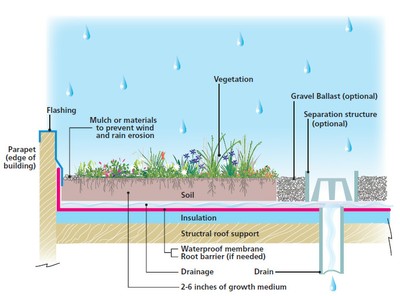In Portland, green roofs have moved so far beyond enviro-novelty that the city is actually paying its residents to cap their homes and businesses in living roofs. Residents there are encouraged to apply for refunds of up to $5 a square foot for roofs that are covered in dirt and planted with grasses and sedums.
But that’s only the capper to Portland’s widespread support of green roofs. In March, the city hosted the Ecoroof Portland 2010 conference that included a tour of notable rooftops. Two years ago, city leaders set a goal of 43 acres of planted roofs; so far there are 211 green roofs covering 11 acres. Portland has an ecoroof blog, ecoroof handbooks, and a schedule of ecoroof talks with titles such as”Skyrise Nature: Designing Ecoroofs for Wildlife.”
And what exactly is a green roof? No, it’s not letting your composite or cedar shingles become coated in a carpet of moss while the gutters sprout dandelions. Ecoroofs are carefully engineered to function as a long-lasting, water-proof roof while also providing environmental benefits that include soaking up rain to control stormwater runoff, insulating a building to cut energy use, and helping clean the air. In some cases, they’re also a place to grow veggies and fruit.

The basic construction starts with a regular rooftop, such as a torch-down asphalt roof that covers a garage. On top of that is insulation, then a waterproof membrane, which can be sheets of modified asphalt or what are called thermoplastic membranes. Then comes a root barrier made of dense plastic, then a drainage layer of gravel or an egg carton-like substrate. Soil and drought-tolerant plants are on the top of the roof.
Admittedly, it sounds pretty weird. After all, the whole point of a traditional roof is to get water off the danged thing as fast as you can and keep it clean of plants. In the case of green roofs—as with low-impact development generally—that notion is flipped and the strategy becomes keeping the water where it falls so that it can soak into the soil, get taken up by plants, and slowly evaporate, in essence to imitate what happens in nature.
So how has Portland gotten its populace to turn the idea of a roof on its head?
 It’s taken time. Tom Liptan, the city’s ecoroof technical program manager, is credited with installing Portland’s first ecoroof in 1996. Slowly other green roofs started cropping up and the city began a concerted effort to foster the construction of ecoroofs.
It’s taken time. Tom Liptan, the city’s ecoroof technical program manager, is credited with installing Portland’s first ecoroof in 1996. Slowly other green roofs started cropping up and the city began a concerted effort to foster the construction of ecoroofs.
The city and the University of Oregon scientists have made careful studies of what building materials and designs work best in the Northwest. They’ve researched what kinds of soil and plants perform well on rooftops. They’ve studied the costs of building and maintaining the roofs, concluding that over time they’re a smart investment. And they’ve documented the work to educate and inspire others.
Convinced of the economic and environmental benefits of the roofs, the city has taken steps to win over more developers and building owners. The latest tactic is the refund program. Until June 1, Portland officials are accepting applications for a program that will pay up to $5 a square foot to install green roofs (the going rate for an ecoroof is $6 to $40 a square foot, depending on whether the project is a new or re-roof, and due to other features). The rebate program runs until 2013, with the next application deadline on Dec. 1.
City leaders have taken other steps to encourage the spread of green roofs, including trade offs for developers that allow them to build taller high rises if they install an ecoroof. A city resolution requires that when a roof on a city building needs to be replaced that it’s rebuilt as a living roof, unless unfeasible. And homeowners can sometimes get a break on their sewer utility bills for curbing stormwater runoff with their green roof.
It’s a smart strategy. The city has assembled the research that makes the case for building the roofs, then offers incentives to get folks to take the next step. It’s an approach that could, and should, be embraced in Seattle, Vancouver, and other Northwest cities that are struggling to deal with stormwater pollution that comes from roofs and other hard surfaces. Granted, these neighboring cities have taken smaller steps to encourage the use of this low-impact development device, but for now, the roofs are always greener in Portland.
Ecoroof diagram is taken from the city of Portland’s “Ecoroof Handbook 2009.”
Green roof photo is courtesy of Flickr user Ben Amstutz under a Creative Commons license.






